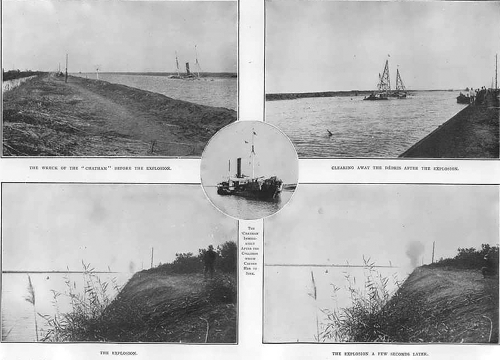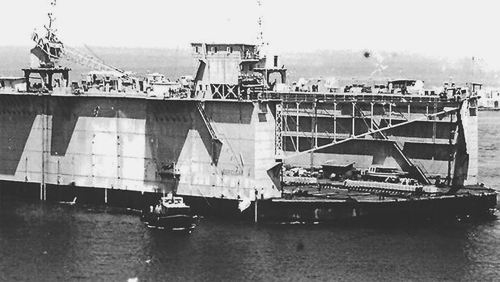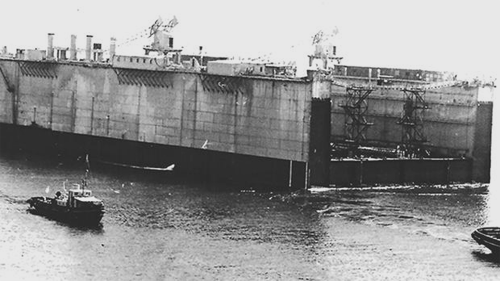5th
September 1905 – S.S. Chatham in collision with Clan Cumming
At 7pm on Saturday, 5th September 1905, the Chatham, a steel screw steamship
of 2174 tons, was in the Suez Canal travelling from London to Bangkok with
a cargo of super-phosphate, pig iron, coke, 80 tons of dynamite and detonators.
She was heading south-ward when the Clan Cumming approached. As the two vessels
were about 1½ miles distant from each other, measures were taken for
tying up the Chatham to the east bank to allow the Clan Cumming to pass. She
was brought close to the bank and her anchor dropped. Clan Cumming was a ¼
mile away, but continued to approach at full speed with her green light open
on the starboard bow of the Chatham, but when only a short distance away she
opened her red light and shut in her green light, causing imminent danger
of collision, and coming on fast, though at the last moment sounding three
short blasts on her whistle, with her stern struck the bluff of the starboard
bow of the Chatham a violent blow , cutting right into her forecastle. The
force of the collision broke down the bulkhead of the Chatham, causing the
lamp which was attached to it to fall and set the contents of the forecastle
on fire. The forehold was afterwards flooded to prevent the fire from spreading
to the explosives which were stowed there and the vessel became submerged.

10 days after the collision, on the day set aside for the explosion, many of the inhabitants of Port Said closed their houses and camped out at a considerable distance. Firing charges were laid in the wreck, cordons of troops kept sightseers out of the danger-zone, and then the explosives were fired by means of electricity. Immediately a large column of water, sand and debris was flung 3000 feet or so into the air, thirty five seconds elapsed between the rise of the column of water and its fall. The debris was removed to Port Said and considering the magnitude of the explosive, very little damage was done, and it was announced on October 9 that traffic through the canal had been resumed.
May 1947 – Not Actually a Ship But a Huge Floating Dock That Stopped Traffic
 |
BECAUSE IT
WAS TOO BIG to pass
|
Admiralty Floating Dock 35 was completed in Calcutta by Braithwaite, Burn & Jessop in May 1944. Assembly was completed at Bombay in May 1946 – the distance between the two is 2,096 nautical miles. ADF 35 seemed to be destined to be towed over long distances from the start. An even longer one was planned.
“Operation Snowhite” was the code name given to the operation to tow floating docks AFD 22, 26 & 35 from Bombay to Europe. AFD 35, the largest, to Malta, AFD 22 to Gibraltar and AFD 26 for the UK. The 4,000 mile voyage to Malta began at Bombay on March 20.
AFD 35 was an autonomous and highly complex vessel, with scores of work stations, ranging from offices, fuel tanks, wash rooms, paint, spare parts and canvas stores, crew’s quarters and machinery rooms. 261.4 metres long, 52.4 metres wide and 12.2 metres deep. The width between the walls was 38.6 metres and the height above the pontoon 12.2 metres. The dock was divided into seven sections, with sections 3, 4 and 5 making up the central, deeper section, and sections 1 & 2, and 6 & 7, fore and aft respectively. The total displacement was 28,000 tons, the lifting capacity 50,000, sufficient for HMS Vanguard, the largest warship in the Royal Navy at that time.


The dock sank by gravity to a depth of 48 feet within two hours. There were seven 30,000 gallons-per-hour centrifugal pumps to empty the pontoon and raise ships for docking. The whole operation for sinking, manoeuvring the ship into the dock, mooring and shoring the vessel took about four hours.
There were four oil-fired boilers on the port side; they produced 20,000lbs of steam per hour. The boilers were installed in pairs in two pressurised compartments using the closed stokehold system. They supplied steam to three 1,000KW, 3,300 volt turbo-alternator sets in two separate engine rooms, the turbines running at 6,500rpm. The converting plant changed 1,200KW of alternating current to direct current.
Two evaporating plants provided 100 tons of distilled water per day. There were several power points for welding. Two travelling cranes on each of the side walls handled loads from two to four tons. Access from one side wall to the other was by flying bridge at the forward section; this could be opened to let vessels through. The dock master had the overall responsibility for docking and undocking ships; the foreman of the yard was responsible for the docking arrangements.
The huge dock was originally built in three sections. The fore and aft sections were joined together for the voyage. The centre section was towed separately. Seven tugs executed the 49 day tow at an average speed of five knots. Speed was reduced when rough seas were met in the Gulf of Suez and in the Mediterranean. The most challenging part of the operation was the passage, with just a few feet of clearance, through the railway swing bridge at El Firdan in the Suez Canal.
The sections arrived off Grand Harbour on the evening of May 7. The centre section was towed in the next morning; the other followed in the afternoon. Both sections were moored at Boiler Wharf. Braithwaite, Burn & Jessop sent over several Indian personnel for the next part of the operation; to disassemble fore and aft sections and join them to the middle. The work was completed in July 1948.
In 1959, the dockyard was leased to C.H. Bailey, a Welsh repair firm. The Admiralty remained responsible for docking and Bailey provided labour on commercial ships. AFD 35 was tested to the full with the docking of some very large oil tankers, such as the 53,000 ton George F. Getty in February 1961.
In August 1964, the Ministry of Defence issued tenders for the sale of AFD 35. The tender was awarded on September 9 to C. Bajada & Son, Coal Importers, established in 1898. Efforts to retain the dock for use in Grand Harbour failed. Bajada asked for government support and then offered to enter into partnership with Swan Hunter who, with its dockyard expansion programme completed, was not interested.
In January 1965, Cantieri Navali Santa Maria of Genoa entered into negotiations with Bajada to purchase the dock. The sale concluded on March 11, but delivery was delayed until June 5 when the government issued an export licence. The Italians commissioned a German towage company to tow the dock to La Spezia. A lot of planning went into the operation and the dock which had arrived in two sections would be leaving as one. At Corradino, Magazine and Laboratory wharves were revealed for the first time after being hidden behind the dock walls.
ADF 35 arrived at
La Spezia on June 9, in September it was sold to C.Y. Tung, a Hong Kong Chinese
shipping magnate. Once again the sections were separated for the long voyage
east to Yokohama. The dock served Mitsubishi until 1971. between 1971 and
1982 it was operated at Hong Kong by Overseas Drydock Corp at the Tsing Yi
Yard. In 1995 is left Hong Kong for demolition in Xinhui, China
And
Of Course, The One Most Canal Zoners Will Remember -
31st December 1954 – ‘World Peace’ Hits El Firdan Bridge

For three days, over 200 ships bound for the Suez Canal were delayed by a terrible accident. The Greek owned tanker, ‘World Peace’, was steaming second in convoy bound for Port Said when her steering gear broke down and she collided with one of the piers of the El Firdan road and railway bridge. One of the wings of the bridge collapsed across the deck of the tanker, the other end being jammed into the sand on the west bank of the Canal.
When the bridge is open the spans run north and south, parallel with the canal banks. The World Peace, when more than halfway through, apparently swung toward the west bank and hit one of the opened spans and carried it off the pier supports. The fact that the tanker was loaded with crude oil prevented the hundreds of workmen called from starting work immediately with acetylene torches to cut away the steel span.
Fire brigades hurried to the scene with orders to be ready to face the risk of an explosion. Although there were no casualties, the damage is described by the Suez Canal Company as “very serious”.
It took the best part of three days and nights to cut away the 350 tons of metal on the tankers superstructure; in addition, there was danger of fire as the World Peace was loaded with crude oil.
Meanwhile, vessels were gathering at Port Said and Suez, and along the canal stretched the rest of the convoy held up by the accident. In the Mediterranean and Red Sea oncoming ships were reducing speed so as to avoid further congestion. The cost of the delay of each vessel was between £1,000 and £3,500 a day. But the shopkeepers and merchants of Suez and Port Said enjoyed an unprecedented boom.
El Firdan Bridge is a double-spanned swing type with an opening of 197 feet. It was built by the British during the build up for the Alamein campaign in North Africa during WWII to carry a railroad across the Canal. It has long been regarded as a menace to navigation, and was due to be scraped in another month.